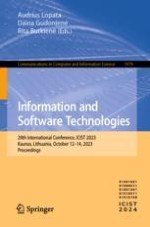This book constitutes the refereed proceedings of the 29th International Conference on Information and Software Technologies, ICIST 2023, held in Kaunas, Lithuania, in October 2023.
The 27 full papers included in this volume were carefully reviewed and selected from 75 submissions. These proceedings contain a diverse array of research and insights in the field of Information Technology and related areas, such as: intelligent systems and software engineering advances, intelligent methods for data analysis and computer aided software engineering, language technologies and smart e-learning applications, AI-based it solutions.
